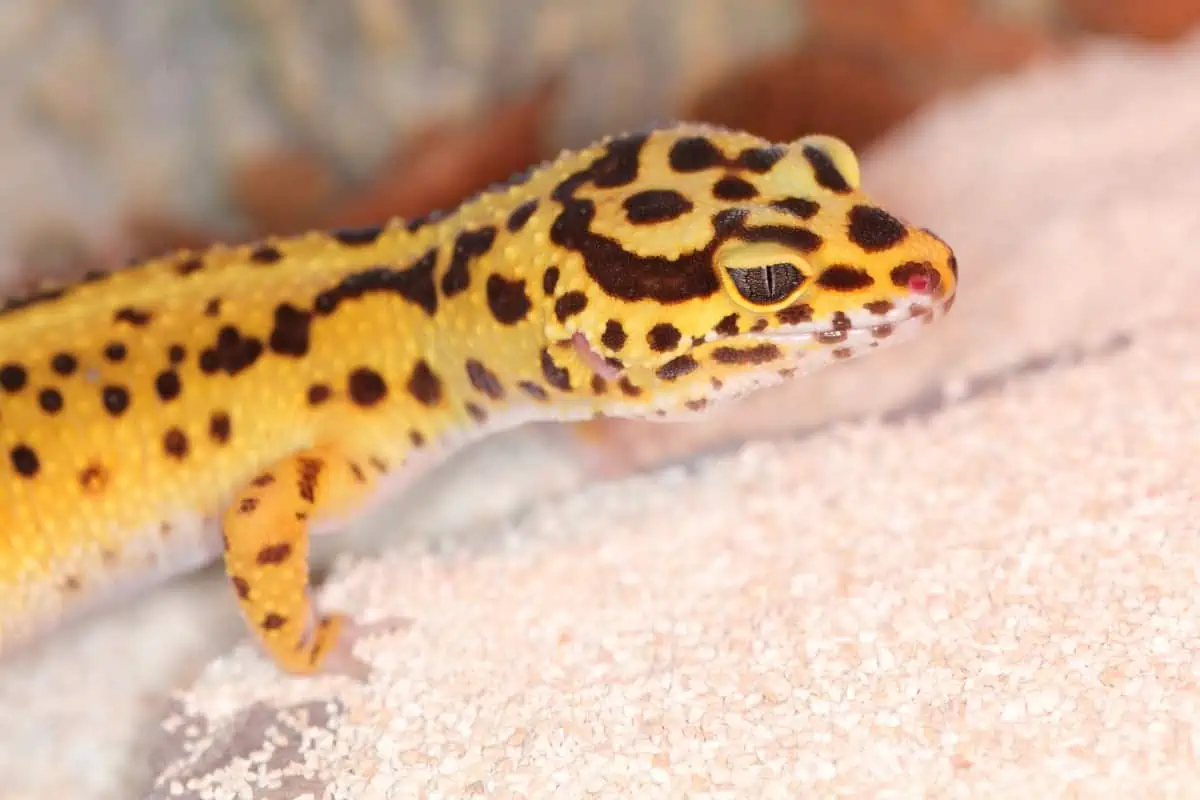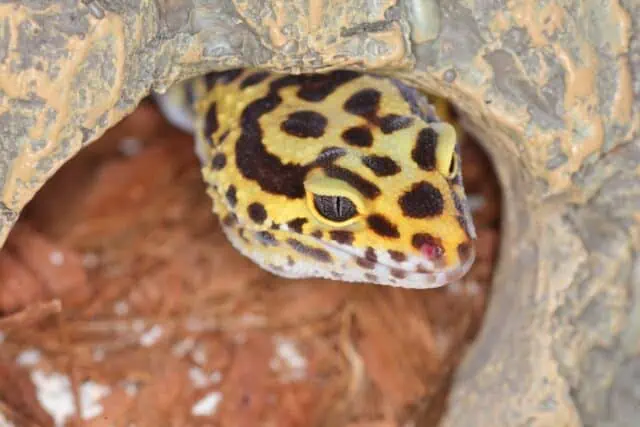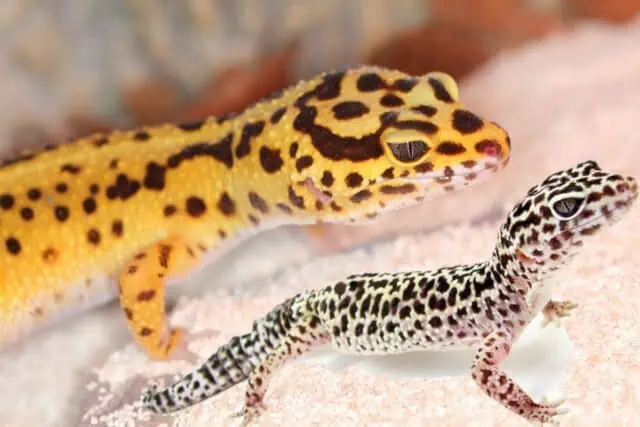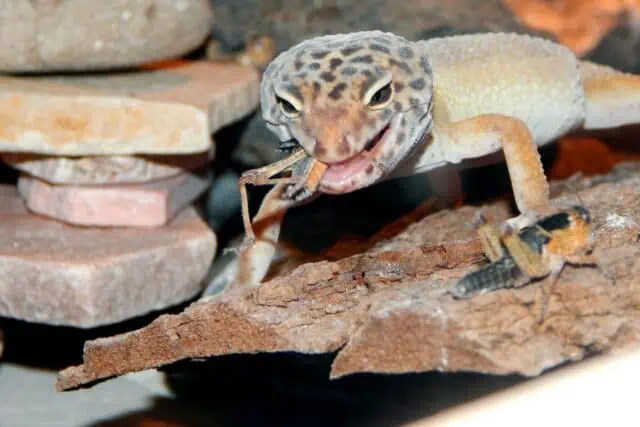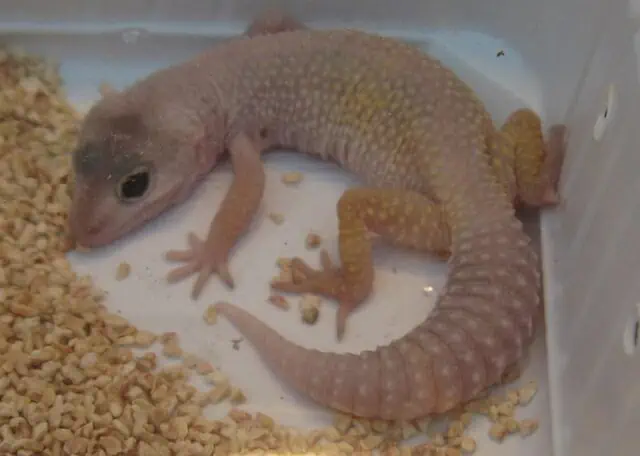Leopard geckos are fascinating creatures, known for their unique patterns and docile nature. But like all reptiles, they have specific dietary needs that must be met to ensure their health and longevity. One of the most crucial aspects of their diet is their calcium intake. Understanding the leopard gecko calcium needs is essential for any owner, whether you’re a beginner or a seasoned enthusiast.
Calcium plays a pivotal role in the health of leopard geckos. It’s not just about strong bones; it’s about their overall well-being. Calcium is vital for their growth, bone development, and even the process of egg laying for female geckos.
Leopard Gecko Calcium Needs – The Basics
When we think of leopard geckos, the first things that might come to mind are their vibrant colors, distinctive patterns, and curious eyes. But beneath that captivating exterior lies a complex biological system that heavily relies on proper nutrition, particularly calcium. Understanding the leopard gecko calcium needs is not just about ensuring they get enough of this mineral, but it’s about understanding the role calcium plays in their overall health and well-being.
Calcium is a cornerstone of health for these reptiles. It’s instrumental in ensuring healthy growth, robust bone development, and successful egg laying in females. Just imagine the intricate process of bone formation or the delicate phase of egg development; both heavily depend on calcium. Without adequate calcium, a leopard gecko’s health can deteriorate rapidly, leading to skeletal issues and reproductive challenges.
In their natural habitat, leopard geckos have evolved to derive calcium from various sources. The soil beneath their feet, the mineral deposits they might encounter, and the insects they hunt down all contribute to their calcium intake. These natural sources of calcium are often rich and varied, ensuring that the gecko’s dietary needs are met.
However, in captivity, the story changes. The environment is controlled, and the diet is often limited to what we provide. This means that the insects they eat might not be as calcium-rich as those found in the wild. Furthermore, the absence of other natural calcium sources makes it imperative for owners to consider calcium supplementation.
In essence, while nature has equipped leopard geckos with the ability to source calcium from their environment, in captivity, it becomes our responsibility to ensure they get what they need. Calcium supplementation, therefore, isn’t just an option; it’s a necessity.
Sources of Calcium
Calcium is undeniably vital for leopard geckos, but where does this essential mineral come from? In the wild, these reptiles have a buffet of natural sources at their disposal. In captivity, however, we need to be more intentional about their calcium intake.
Natural Sources From Leopard Gecko’s Diet
In the wild, leopard geckos have a variety of natural sources from which they derive their calcium. These sources range from the soil they tread upon to the insects they prey on. Some of the most common natural sources of calcium for these reptiles include mineral-rich soils, certain types of plants, and specific insects that are calcium-rich.
However, it’s essential to note that not all feeder insects are created equal when it comes to calcium content. While many of the commonly fed insects might be lacking in sufficient calcium, there are some, like black soldier fly larvae, that are known to provide a good amount of this vital mineral. It’s these calcium-rich food items that become crucial, especially when we consider the dietary needs of leopard geckos in captivity.
Calcium Supplements
While natural sources are invaluable, calcium supplements play an equally crucial role, especially in captivity. There’s a myriad of calcium supplements available for leopard geckos in the market, each tailored to meet specific needs. When choosing a supplement, one of the most critical factors to consider is the calcium to phosphorus ratio. An optimal ratio of 2:1 is recommended, ensuring that the gecko absorbs the calcium efficiently without any hindrance from excessive phosphorus.
Beyond the traditional powdered supplements, there are calcium snacks that can be a treat for geckos while also serving a nutritional purpose. Items like cuttlebone and sepia bone are not just for birds; they can be beneficial for geckos too, especially those that are calcium deficient or are in the breeding phase. These snacks provide a concentrated source of calcium that can be easily integrated into their diet.
Administering calcium to leopard geckos is a straightforward process but requires consistency. Here’s how to do it:
Dusting Feeder Insects: Before feeding the insects to your gecko, place them in a bag with calcium powder. Gently shake the bag to ensure the insects are well-coated. This method ensures that the gecko gets calcium directly with its primary food source.
Calcium Dish: Another effective method is to keep a small dish filled with calcium powder in the gecko’s enclosure. Leopard geckos instinctively know when they need calcium and will lick the powder from the dish as needed.
UVB Lights
UVB lights have become a topic of keen interest among leopard gecko enthusiasts, and for a good reason. These lights play a pivotal role in the health and well-being of these reptiles. UVB lights are not just about illumination; they are instrumental in vitamin D3 production, which in turn, is vital for proper calcium absorption in leopard geckos.
Vitamin D3 acts as a catalyst, allowing the gecko’s body to absorb and utilize the calcium it consumes. Without adequate vitamin D3, even if a gecko consumes enough calcium, it won’t be able to use it effectively. This is where UVB lights come into play. When a leopard gecko is exposed to UVB rays, its skin produces vitamin D3, facilitating the absorption of calcium from its diet.
However, there’s an ongoing debate in the reptile community. If a leopard gecko is exposed to UVB lights and produces its own vitamin D3, does it still need additional vitamin D3 supplementation? Some argue that UVB exposure is sufficient, while others believe that a little extra supplementation ensures the gecko’s needs are met, especially in captivity where natural sunlight is limited.
The stakes are high in this debate because the consequences of inadequate vitamin D3 and calcium absorption are severe. One of the most alarming risks is the development of metabolic bone disease. This condition results from a calcium deficiency and can lead to skeletal deformities, weakness, and in severe cases, can be fatal for the gecko.
Benefits of a Healthy Diet & Calcium Intake
A leopard gecko’s diet is more than just sustenance; it’s the foundation of their health, vitality, and overall well-being. Ensuring they receive the right nutrients, especially calcium, can profoundly impact their quality of life.
Healthy Bones and Joints
For leopard geckos, just as with many other creatures, healthy bones and joints are the very pillars of their physical well-being. Calcium is the unsung hero behind this robust skeletal framework. It plays an indispensable role in the formation, growth, and maintenance of bones and joints, ensuring that these reptiles can move, hunt, and interact with their environment effectively.
However, the absence of adequate calcium can spell disaster for a gecko’s skeletal system. Calcium deficiency doesn’t just result in weaker bones; it can lead to severe skeletal deformities. These deformities not only affect the gecko’s mobility but can also impair its unique ability to regenerate body parts, a fascinating aspect of these reptiles. Imagine a tail that doesn’t grow back correctly or a limb that’s malformed; these are the grim realities of calcium deficiency.
Mineral Deposits in the Skeleton
The skeleton of a leopard gecko is a marvel of nature, a complex structure that relies heavily on mineral deposits for its strength and durability. At the heart of this process is calcium, acting as the primary mineral that gets deposited in the gecko’s bones. This deposition is a continuous process, where calcium is integrated into the bone matrix, providing the rigidity and strength that the skeleton requires.
But it’s not just the bones that benefit from calcium. The teeth of leopard geckos, though tiny, are equally reliant on this mineral. Calcium ensures that their teeth remain strong, allowing them to grasp and consume their prey effectively. Without adequate calcium, both the bones and teeth of a gecko can become brittle and weak, making them susceptible to fractures and other injuries.
Improved Immune System and Metabolism
A well-rounded diet, complemented by the right calcium intake, does wonders for a leopard gecko’s overall health. It’s not just about strong bones or vibrant colors; it’s about the intricate systems working seamlessly within these reptiles. One of the most profound benefits of proper nutrition and calcium intake is the boost it provides to the gecko’s immune system. A robust immune system is the first line of defense against various pathogens, ensuring that the gecko remains healthy and less susceptible to diseases.
Furthermore, a balanced diet plays a pivotal role in optimizing the gecko’s metabolism. Metabolism, in simple terms, is the process by which the body converts food into energy. Proper calcium levels ensure that this metabolic process runs smoothly, allowing the gecko to derive the maximum energy from its food and maintain an active lifestyle.
How to Achieve Appropriate Calcium Intake for Leopard Geckos
Ensuring that your leopard gecko receives the right amount of calcium is both an art and a science. While understanding their calcium needs is essential, knowing how to meet those needs effectively is equally crucial.
Properly Balanced Diet with Leafy Greens or Insects as Main Source of Food
A properly balanced diet is the cornerstone of health for leopard geckos. While these reptiles are primarily insectivores, some owners have found success in introducing leafy greens into their diet. Whether you’re offering them a crunchy cricket or a fresh piece of kale, the key is to ensure that the food is nutritious and meets their dietary needs.
However, there’s a catch when it comes to feeder insects. While they are the mainstay of a leopard gecko’s diet, many of these insects are naturally low in calcium and high in phosphorus. This imbalance can be problematic as it can hinder the effective absorption of calcium, emphasizing the importance of calcium supplementation. Simply put, even if your gecko is feasting on a buffet of insects, they might still be missing out on essential calcium.
One effective strategy to counteract this is gut-loading. Gut-loading involves feeding the feeder insects a nutrient-rich diet before they are offered to the gecko. This process ensures that the insects are not just filling, but also nutritionally dense, providing the gecko with a more balanced meal.
Supplementation with Multivitamin Supplements or Repashy Calcium Plus
While a balanced diet is fundamental, sometimes it’s not enough to meet all the nutritional needs of leopard geckos, especially when it comes to calcium. This is where multivitamin supplements and specialized products like Repashy Calcium Plus come into play. These supplements are meticulously formulated to fill any nutritional gaps, ensuring that the gecko receives a well-rounded diet.
Repashy Calcium Plus, for instance, is more than just a calcium supplement. It’s a blend of essential vitamins and minerals tailored to meet the unique needs of reptiles. Using such supplements is vital not just for maintaining optimal health but also to prevent potential deficiencies that can arise from a diet that’s not diverse enough.
Conclusion
Leopard geckos, with their captivating patterns and docile nature, are a joy to care for. However, their health and well-being hinge on a delicate balance of nutrition, especially calcium.
From understanding their natural dietary sources to the intricacies of supplementation, ensuring they receive the right amount of calcium is paramount.
With a blend of a balanced diet, strategic supplementation, and consistent care, you can ensure that your leopard gecko thrives, leading a life full of vitality and vigor.
FAQs
Why is calcium so important for leopard geckos?
For leopard geckos, calcium is a foundational nutrient. It’s intricately linked to their growth, the health of their bones, and the egg-laying process. Without sufficient calcium, they can face significant health challenges, including conditions like metabolic bone disease.
Can I rely solely on natural food sources to provide enough calcium for my leopard gecko?
Natural food sources do offer calcium, but many of the insects typically fed to geckos have a calcium-to-phosphorus ratio that’s not ideal. Solely depending on these can lead to a calcium shortfall. Augmenting their diet with calcium supplements is often recommended.
How can I ensure my feeder insects are nutritionally beneficial for my gecko?
One effective strategy is gut-loading. This involves nourishing the insects with a nutrient-packed diet before they’re given to the gecko. This process ensures the insects are not just satiating but also nutritionally rich.
Do leopard geckos need UVB lighting for calcium absorption?
Absolutely, UVB lighting is pivotal for leopard geckos. It aids them in synthesizing vitamin D3, a vital component for the effective absorption of calcium. Without adequate D3, the benefits of a calcium-rich diet might not be fully realized.
Is there a risk of giving my leopard gecko too much calcium?
Indeed, while calcium is indispensable, an excess can lead to health issues. It’s vital to maintain a balanced approach, ensuring the right calcium to phosphorus ratio in their dietary intake.

